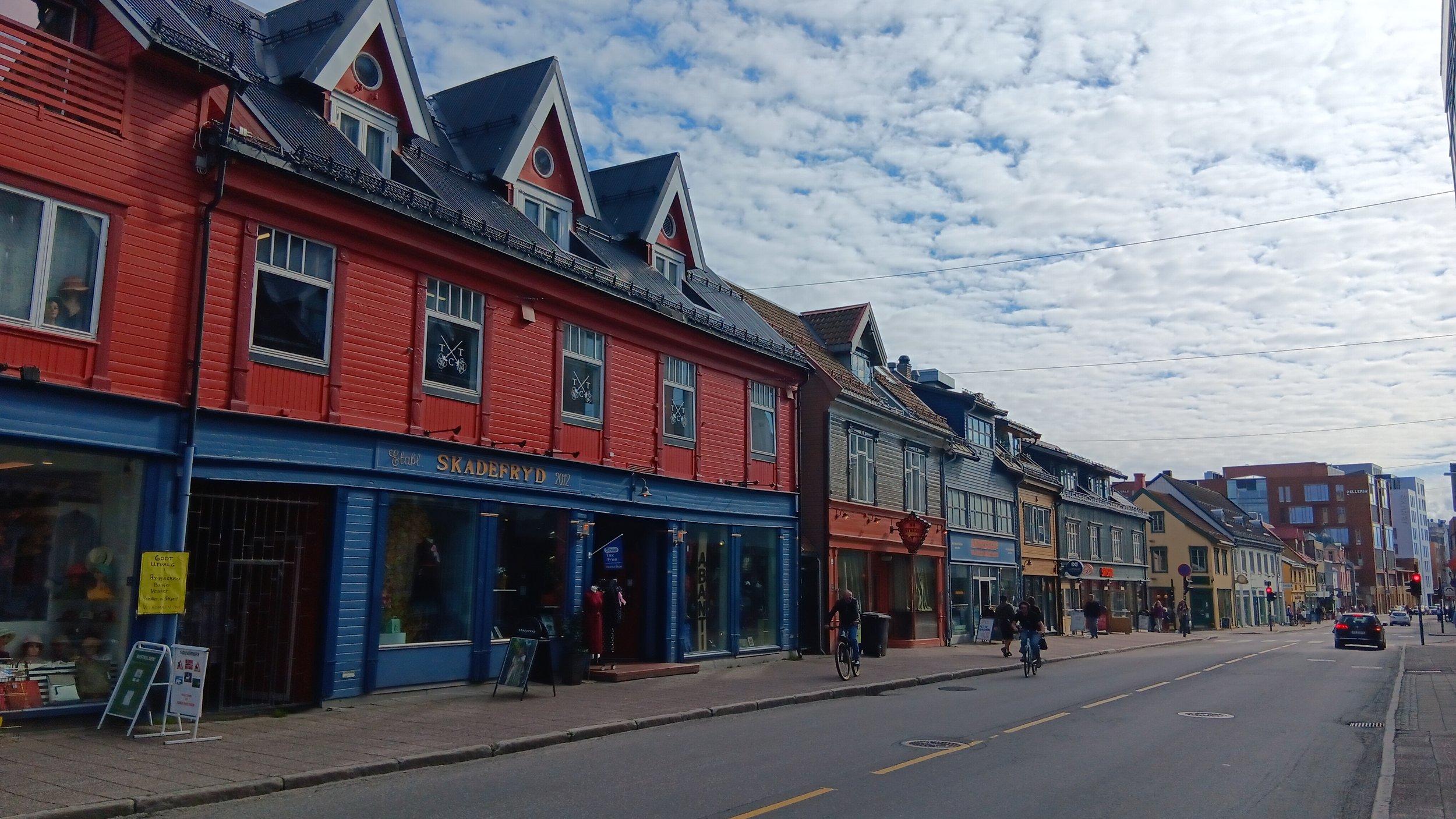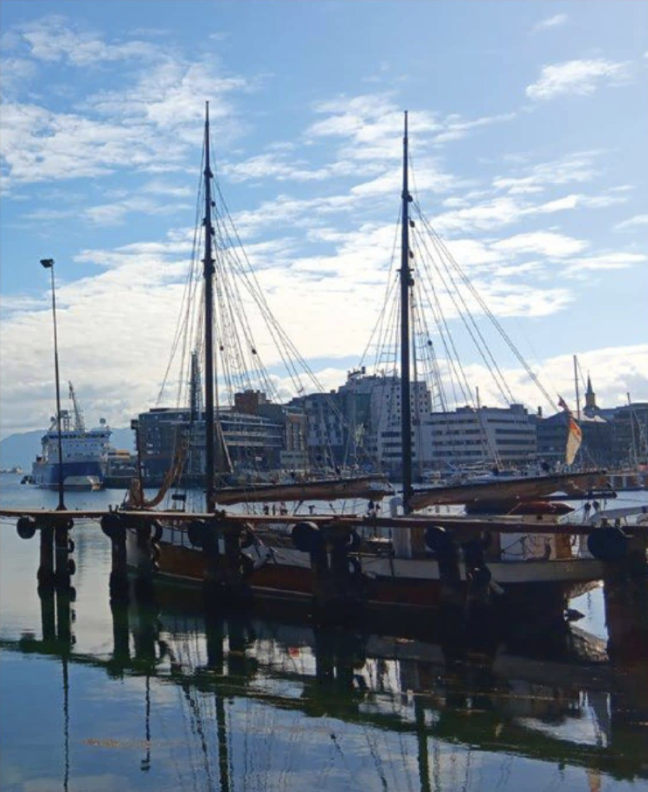Paris of the North
Despite its moniker as the Paris of the North, not many people know about Tromsø. The northernmost city on the planet is a perfect place to watch the Northern Lights in the winter, but what can a tiny capital, with a population just under 42,000, offer in the summertime? Plenty! While only 13.7 square kilometres, the town centre balances traditional and modern architecture, giving visitors the sense of walking through time. Mouth-watering cuisine made us anxious to eat our next meal. The lush, wild landscape brought children’s illustrated books to mind. Over six days, we were enamoured by near-constant daylight and felt embraced by the openhearted spirit of the Norwegians, So much so that by the end, we were seriously considering a winter visit.
Local cuisine is often the heart of a culture. In Tromsø, seafood dishes are the order of the day. It’s no wonder. Besides being located next to the Norwegian Sea, numerous rivers and freshwater lakes are scattered across the surrounding area. Fishing was so prolific here that, in the nineteenth century, it was known as the gateway to the Arctic.
On our first night in the city, we wandered around the square, looking for an authentic Norwegian restaurant.
Immediately opting against McDonald’s and Chinese food, a humble sign bearing the phrase Nyt (Norwegian for enjoy) won us over. Much as we wanted to indulge in unique delicacies, we were still tourists, and our order came out as a mixed bag of hyped food and genuine local dishes.
Reindeer tacos, corn tortillas piled with seasoned reindeer meat, lingonberry cream, pickled onion, and cornflakes, were surprisingly vibrant. While eating his tacos, our friend noted they tasted much like beef. “But,” he shrugged, “we’re on vacation.” Our other friend, who ordered a reindeer burger, enjoyed the half he ate. The other half met its untimely end, falling to the ground as his baby daughter flung her arms at him.
The pan-fried halibut did not disappoint. Delicately seared, the fish split like melted butter at the slightest touch. Celery purée balanced the flavour profile, and brown butter paired brilliantly with the potatoes and broccolini.
Homemade fish soup, a creamy dish of halibut and shrimp, looked hearty and high-class all at once. A crudité of fennel introduced a sharpness to the dish. Bread and butter were welcome sides to help gather the last bits of soup. Waste not, want not!
We were warned about the high prices of dining out in Norway, but we had nothing to worry about. Being from Hong Kong, dining out prices were fairly comparable. So, we had no trouble eating like kings for the remainder of our stay, feasting on fresh clams, shrimp, cod, and, of course, fish soup.
While making our way to meet our friends for lunch, we passed by an advertisement, pronouncing in big, bold letters that a MIDNIGHT CONCERT would take place at Tromsø Cathedral. Built in 1861, Norway’s only wooden cathedral is distinctly set in the middle of the city. Coloured with a warm, pale yellow, the church entrance is situated under the bell tower.
When I returned to the cathedral a few evenings later, I was struck by its simple sincerity. While many Western European cathedrals are monuments to artistry as much as religion, the unaffected decor gave the cathedral an air of humble solemnity.
A single illustration, a copy of Adolph Tidemand’s Resurrection), took pride of place at the centre of the altar. On either side of the portrait stand stained- glass interpretations of Jesus and the cross, their presence emphasising the gravity of the painting instead of taking away from it.
The concert was a haunting experience. I listened intently as the singer belted out Norwegian hymns of romance and hardships, her voice echoing through the walls. The saxophonist’s tenor harmonised perfectly with her soprano, and the pianist’s gentle tunes sounded like gentle breezes flowing in from the ocean. Too soon, the concert ended. When I left the cathedral, I couldn’t help but laugh. It was almost one in the morning, and the sky was shimmering in pink and orange pastels.
Blessed by our cathedral experience, we were not accosted by trolls on our late-night walk back to the hotel. However, if the Troll Museum is to be trusted, this was not a certainty. Norway’s trolls are not as Disney would have you believe. As Norse people traditionally live in small, isolated villages, much of their lore revolves around what hides in the surrounding wilderness.
The mountain troll is the most prolific of Norway’s mythical beings. Said to have descended from primordial gods, mountain trolls are fur-covered and (possibly) many-headed. Despite their self-imposed mountain isolation, they greedily hoard gems and gold and are constantly looking for more. Their strength is horrifying; a single troll can crack a boulder in half. But in the sun, there is salvation. If you find yourself pursued by a mountain troll, hide until the first rays of dawn. At the first light of day, the troll will turn to stone.
Those protective rays also provide comfortable summer days. Compared to other northern cities, Tromsø is uncommonly warm. This is thanks to the Gulf Stream’s water-warming effect, which makes this coastal climate milder than its peers. The weather was comfortable even for us Hong Kongers! So, in little more than trousers and t-shirts, we followed our local friend into the forest.
After our friend initially taught us how to identify ripe berries, I distantly followed the group, preferring to grab a handful of sustenance now and then. These wild berries gave a satisfying POP as I chewed. I was surprised by the abundance of alder trees, which I initially mistook for birch. At first glance, they do look similar – ashy bark stripped back here and there, wispy branches that shiver at a slight breeze. But upon closer inspection, these trees had rounded leaves – birches have pointed ones. And to my amazement, the trees showed a clear history of rough winds and resilience. Many were bent at odd angles, still moving upwards against all odds.
Taking a detour through a local fish pond (Fiskeparken), we all thought it should be renamed andedammen for all the ducks (the seagulls and pigeons were clearly just visiting). Admittedly, some of us were very excited by the ducks. One of us even ran to the end of the barge, arms spread out, only for the confused seagulls and pigeons to squall and flap away. That wasn’t me. I was the one screaming “DUCK” every five minutes and taking more pictures of the announced aviary than I care to admit.
Of all the available summer tourist spots, only the ski jump was a surprise. But it was worth the walk-up. The waiting area at the top of the ski jump gave a clear view of Tromsø in its entirety. We took turns pointing out every one of its physical landmarks. By the time our live game of I Spy was done, the sunlight had dimmed slightly, and we needed to get back to the city proper for dinner.
During our last dinner in Tromsø, we all agreed that its unique blend of natural beauty, rich culture, and warm hospitality had captured our hearts. From the mouthwatering seafood to the enchanting midnight concerts, each experience was rewarding.
While summer offers its own magic, every local we interacted with declared that the festive winter season was Tromsø at its best.
With reindeer and dog sled rides, Aurora borealis, ice fishing, and polar bear sightings, this Norwegian city located sixty- nine degrees north has much to offer year-round.
Originally published in CULTURE Magazine Issue 236 (August-September 2024)


